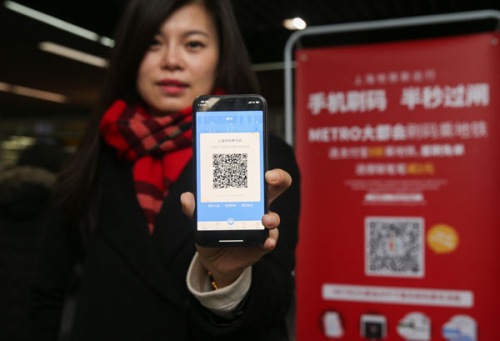
A passenger shows her QR code to enter the metro station at the People's Square in Shanghai. (Photo/Xinhua)
Mobile wallets backed by various payment technologies are scrambling to grab a slice of China's public transportation market, which could become a multi-billion dollar business by 2020.
From Saturday, passengers in Shanghai can board underground trains by tapping their smart phones, the latest instance of making mobile payment a default way of life.
Through an app called Metro, passengers can choose to link their accounts with all bank cards issued by China's card payment processor UnionPay, or Alipay, the popular third-party payment platform from Ant Financial Services Group, and have the fees deducted every time they take a ride.
To get going, commuters simply need to present a quick recognition code generated from the application to a scanner installed at the gates of each subway station. The system supports payment even without internet connection, giving passengers the perks of finishing the trip before payment.
This would eliminate the need to bring change to buy tickets or even carry a physical subway card, said Jin Tao, head of the information center at Shanghai Shentong Metro Group Co Ltd, which oversees the world's longest metro network that has an average weekday ridership of 11 million.
He added the company is planning to include other payment providers like WeChat Pay and Apple Pay, to name a few.
Users must go through online identity authentication before registering as virtual metro card holders. Foreigners are temporarily barred from such services at least before June, the local metro authority said.
The attempt follows that of Beijing, with the capital city allowing most Android-powered smartphone users to pay for subway journeys by swiping their gadgets.
Backed by near-field communication technology, phones function as a virtual transit pass that can be installed digitally and easily topped up anytime anywhere. Samsung, Huawei, Xiaomi and other tech firms are jockeying to roll out their versions of contactless payment.
But the Shanghai initiative lowers the threshold by providing the unified QR code as the sole entrance, so that people using Apple phones and an army of other less well-known gadgets stand to benefit from such services.
"NFC and QR codes … are essentially two types of technologies. QR codes currently reach a wider market since more phones can read them than those that can read NFC tags," said Liu Xiaojie, general manager in charge of public services at Ant Financial.
Theoretically, NFC offers faster and more secure transactions and options. But QR codes are commonplace as the Chinese are simply more used to this system of code scanning, said Li Chao, a senior analyst at market research firm iResearch.
The fight for supremacy in mobile payments has heightened since WeChat Pay, backed by another tech titan Tencent Holdings Ltd, marched into transit systems in Guangzhou late last year.


















































